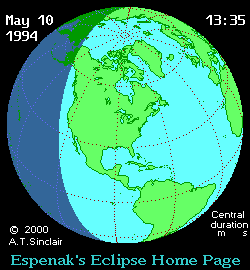| Solar eclipse of May 10, 1994 | |
|---|---|
 Partial from Bismarck, North Dakota, USA Partial from Bismarck, North Dakota, USA | |
 Map Map | |
| Type of eclipse | |
| Nature | Annular |
| Gamma | 0.4077 |
| Magnitude | 0.9431 |
| Maximum eclipse | |
| Duration | 373 s (6 min 13 s) |
| Coordinates | 41°30′N 84°06′W / 41.5°N 84.1°W / 41.5; -84.1 |
| Max. width of band | 230 km (140 mi) |
| Times (UTC) | |
| Greatest eclipse | 17:12:27 |
| References | |
| Saros | 128 (57 of 73) |
| Catalog # (SE5000) | 9495 |
An annular solar eclipse occurred at the Moon's descending node of orbit on Tuesday, May 10, 1994, with a magnitude of 0.9431. A solar eclipse occurs when the Moon passes between Earth and the Sun, thereby totally or partly obscuring the image of the Sun for a viewer on Earth. An annular solar eclipse occurs when the Moon's apparent diameter is smaller than the Sun's, blocking most of the Sun's light and causing the Sun to look like an annulus (ring). An annular eclipse appears as a partial eclipse over a region of the Earth thousands of kilometres wide. Occurring about 1.6 days after apogee (on May 9, 1994, at 3:20 UTC), the Moon's apparent diameter was smaller.
The path of annularity crossed four states of Mexico (Baja California Sur, Baja California, Sonora and Chihuahua), parts of Arizona, New Mexico, Texas, Oklahoma, Kansas, Missouri, Illinois, Indiana, Michigan, Ohio, Pennsylvania, New York, Massachusetts, Vermont, New Hampshire and Maine in the United States, the Canadian provinces of Ontario, Nova Scotia and the southeastern tip of Quebec, the Azores Islands except Santa Maria Island, and part of Morocco including the capital city Rabat. The eclipse reached its moment of "greatest eclipse" in the United States near Wauseon, Ohio, about 35 miles west of Toledo, Ohio. Niagara Falls was also covered by the path of annularity. A partial eclipse was visible for parts of eastern Russia, North America, Central America, the Caribbean, Western Europe, and West Africa.
The Columbus Crew were originally named the "Columbus Eclipse" in their Major League Soccer bid in honor of the event.
Images
Eclipse details
Shown below are two tables displaying details about this particular solar eclipse. The first table outlines times at which the moon's penumbra or umbra attains the specific parameter, and the second table describes various other parameters pertaining to this eclipse.
| Event | Time (UTC) |
|---|---|
| First Penumbral External Contact | 1994 May 10 at 14:13:11.3 UTC |
| First Umbral External Contact | 1994 May 10 at 15:21:36.4 UTC |
| First Central Line | 1994 May 10 at 15:24:17.3 UTC |
| First Umbral Internal Contact | 1994 May 10 at 15:26:58.9 UTC |
| First Penumbral Internal Contact | 1994 May 10 at 16:55:59.3 UTC |
| Ecliptic Conjunction | 1994 May 10 at 17:07:34.4 UTC |
| Greatest Eclipse | 1994 May 10 at 17:12:26.5 UTC |
| Greatest Duration | 1994 May 10 at 17:17:41.1 UTC |
| Equatorial Conjunction | 1994 May 10 at 17:20:50.9 UTC |
| Last Penumbral Internal Contact | 1994 May 10 at 17:28:40.2 UTC |
| Last Umbral Internal Contact | 1994 May 10 at 18:57:48.7 UTC |
| Last Central Line | 1994 May 10 at 19:00:29.5 UTC |
| Last Umbral External Contact | 1994 May 10 at 19:03:09.5 UTC |
| Last Penumbral External Contact | 1994 May 10 at 20:11:35.7 UTC |
| Parameter | Value |
|---|---|
| Eclipse Magnitude | 0.94315 |
| Eclipse Obscuration | 0.88953 |
| Gamma | 0.40771 |
| Sun Right Ascension | 03h09m27.2s |
| Sun Declination | +17°41'21.5" |
| Sun Semi-Diameter | 15'50.2" |
| Sun Equatorial Horizontal Parallax | 08.7" |
| Moon Right Ascension | 03h09m11.3s |
| Moon Declination | +18°03'01.1" |
| Moon Semi-Diameter | 14'44.0" |
| Moon Equatorial Horizontal Parallax | 0°54'04.4" |
| ΔT | 60.3 s |
Eclipse season
See also: Eclipse cycleThis eclipse is part of an eclipse season, a period, roughly every six months, when eclipses occur. Only two (or occasionally three) eclipse seasons occur each year, and each season lasts about 35 days and repeats just short of six months (173 days) later; thus two full eclipse seasons always occur each year. Either two or three eclipses happen each eclipse season. In the sequence below, each eclipse is separated by a fortnight.
| May 10 Descending node (new moon) |
May 25 Ascending node (full moon) |
|---|---|
 |

|
| Annular solar eclipse Solar Saros 128 |
Partial lunar eclipse Lunar Saros 140 |
Related eclipses
Eclipses in 1994
- An annular solar eclipse on May 10.
- A partial lunar eclipse on May 25.
- A total solar eclipse on November 3.
- A penumbral lunar eclipse on November 18.
Metonic
- Preceded by: Solar eclipse of July 22, 1990
- Followed by: Solar eclipse of February 26, 1998
Tzolkinex
- Preceded by: Solar eclipse of March 29, 1987
- Followed by: Solar eclipse of June 21, 2001
Half-Saros
- Preceded by: Lunar eclipse of May 4, 1985
- Followed by: Lunar eclipse of May 16, 2003
Tritos
- Preceded by: Solar eclipse of June 11, 1983
- Followed by: Solar eclipse of April 8, 2005
Solar Saros 128
- Preceded by: Solar eclipse of April 29, 1976
- Followed by: Solar eclipse of May 20, 2012
Inex
- Preceded by: Solar eclipse of May 30, 1965
- Followed by: Solar eclipse of April 20, 2023
Triad
- Preceded by: Solar eclipse of July 10, 1907
- Followed by: Solar eclipse of March 10, 2081
Solar eclipses of 1993–1996
This eclipse is a member of a semester series. An eclipse in a semester series of solar eclipses repeats approximately every 177 days and 4 hours (a semester) at alternating nodes of the Moon's orbit.
| Solar eclipse series sets from 1993 to 1996 | ||||||
|---|---|---|---|---|---|---|
| Descending node | Ascending node | |||||
| Saros | Map | Gamma | Saros | Map | Gamma | |
| 118 | May 21, 1993 Partial |
1.1372 | 123 | November 13, 1993 Partial |
−1.0411 | |
128 Partial in Bismarck, ND, USA |
May 10, 1994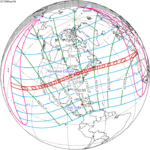 Annular |
0.4077 | 133 Totality in Bolivia |
November 3, 1994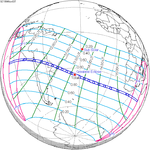 Total |
−0.3522 | |
| 138 | April 29, 1995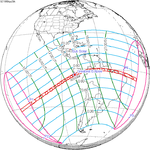 Annular |
−0.3382 | 143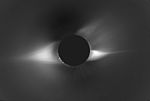 Totality in Dundlod, India |
October 24, 1995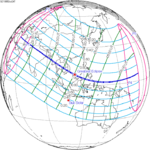 Total |
0.3518 | |
| 148 | April 17, 1996 Partial |
−1.058 | 153 | October 12, 1996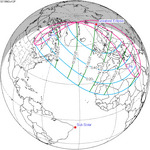 Partial |
1.1227 | |
Saros 128
This eclipse is a part of Saros series 128, repeating every 18 years, 11 days, and containing 73 events. The series started with a partial solar eclipse on August 29, 984 AD. It contains total eclipses from May 16, 1417 through June 18, 1471; hybrid eclipses from June 28, 1489 through July 31, 1543; and annular eclipses from August 11, 1561 through July 25, 2120. The series ends at member 73 as a partial eclipse on November 1, 2282. Its eclipses are tabulated in three columns; every third eclipse in the same column is one exeligmos apart, so they all cast shadows over approximately the same parts of the Earth.
The longest duration of totality was produced by member 27 at 1 minutes, 45 seconds on June 7, 1453, and the longest duration of annularity was produced by member 48 at 8 minutes, 35 seconds on February 1, 1832. All eclipses in this series occur at the Moon’s descending node of orbit.
| Series members 47–68 occur between 1801 and 2200: | ||
|---|---|---|
| 47 | 48 | 49 |
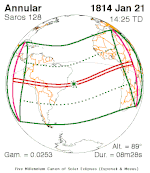 January 21, 1814 |
 February 1, 1832 |
 February 12, 1850 |
| 50 | 51 | 52 |
 February 23, 1868 |
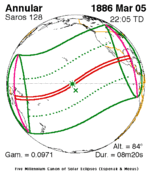 March 5, 1886 |
 March 17, 1904 |
| 53 | 54 | 55 |
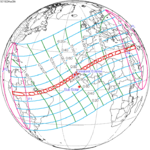 March 28, 1922 |
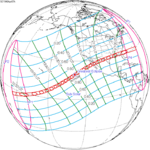 April 7, 1940 |
 April 19, 1958 |
| 56 | 57 | 58 |
 April 29, 1976 |
 May 10, 1994 |
 May 20, 2012 |
| 59 | 60 | 61 |
 June 1, 2030 |
 June 11, 2048 |
 June 22, 2066 |
| 62 | 63 | 64 |
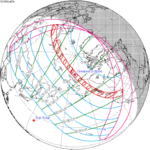 July 3, 2084 |
 July 15, 2102 |
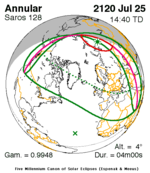 July 25, 2120 |
| 65 | 66 | 67 |
 August 5, 2138 |
 August 16, 2156 |
 August 27, 2174 |
| 68 | ||
 September 6, 2192 | ||
Metonic series
The metonic series repeats eclipses every 19 years (6939.69 days), lasting about 5 cycles. Eclipses occur in nearly the same calendar date. In addition, the octon subseries repeats 1/5 of that or every 3.8 years (1387.94 days). All eclipses in this table occur at the Moon's descending node.
| 21 eclipse events between July 22, 1971 and July 22, 2047 | ||||
|---|---|---|---|---|
| July 22 | May 9–11 | February 26–27 | December 14–15 | October 2–3 |
| 116 | 118 | 120 | 122 | 124 |
 July 22, 1971 |
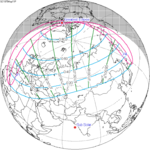 May 11, 1975 |
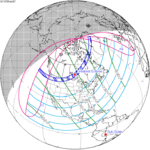 February 26, 1979 |
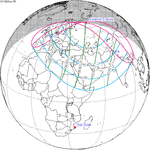 December 15, 1982 |
 October 3, 1986 |
| 126 | 128 | 130 | 132 | 134 |
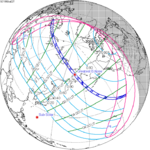 July 22, 1990 |
 May 10, 1994 |
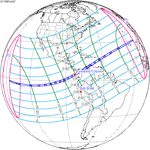 February 26, 1998 |
 December 14, 2001 |
 October 3, 2005 |
| 136 | 138 | 140 | 142 | 144 |
 July 22, 2009 |
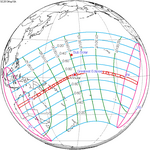 May 10, 2013 |
 February 26, 2017 |
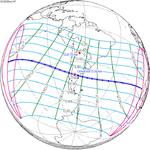 December 14, 2020 |
 October 2, 2024 |
| 146 | 148 | 150 | 152 | 154 |
 July 22, 2028 |
 May 9, 2032 |
 February 27, 2036 |
 December 15, 2039 |
 October 3, 2043 |
| 156 | ||||
 July 22, 2047 | ||||
Tritos series
This eclipse is a part of a tritos cycle, repeating at alternating nodes every 135 synodic months (≈ 3986.63 days, or 11 years minus 1 month). Their appearance and longitude are irregular due to a lack of synchronization with the anomalistic month (period of perigee), but groupings of 3 tritos cycles (≈ 33 years minus 3 months) come close (≈ 434.044 anomalistic months), so eclipses are similar in these groupings.
| Series members between 1801 and 2200 | ||||
|---|---|---|---|---|
 October 19, 1808 (Saros 111) |
 September 19, 1819 (Saros 112) |
 August 18, 1830 (Saros 113) |
 July 18, 1841 (Saros 114) |
 June 17, 1852 (Saros 115) |
 May 17, 1863 (Saros 116) |
 April 16, 1874 (Saros 117) |
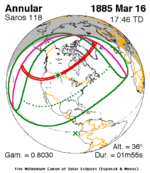 March 16, 1885 (Saros 118) |
 February 13, 1896 (Saros 119) |
 January 14, 1907 (Saros 120) |
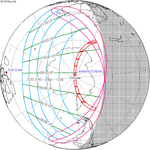 December 14, 1917 (Saros 121) |
 November 12, 1928 (Saros 122) |
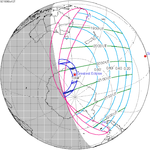 October 12, 1939 (Saros 123) |
 September 12, 1950 (Saros 124) |
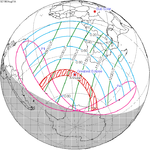 August 11, 1961 (Saros 125) |
 July 10, 1972 (Saros 126) |
 June 11, 1983 (Saros 127) |
 May 10, 1994 (Saros 128) |
 April 8, 2005 (Saros 129) |
 March 9, 2016 (Saros 130) |
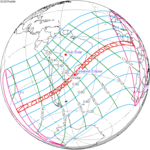 February 6, 2027 (Saros 131) |
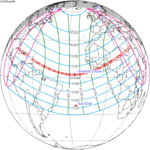 January 5, 2038 (Saros 132) |
 December 5, 2048 (Saros 133) |
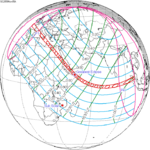 November 5, 2059 (Saros 134) |
 October 4, 2070 (Saros 135) |
 September 3, 2081 (Saros 136) |
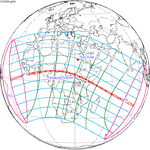 August 3, 2092 (Saros 137) |
 July 4, 2103 (Saros 138) |
 June 3, 2114 (Saros 139) |
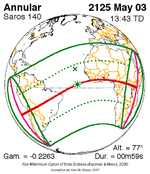 May 3, 2125 (Saros 140) |
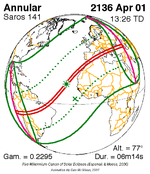 April 1, 2136 (Saros 141) |
 March 2, 2147 (Saros 142) |
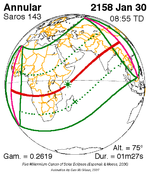 January 30, 2158 (Saros 143) |
 December 29, 2168 (Saros 144) |
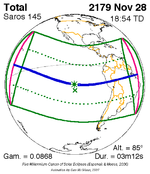 November 28, 2179 (Saros 145) |
 October 29, 2190 (Saros 146) | ||||
Inex series
This eclipse is a part of the long period inex cycle, repeating at alternating nodes, every 358 synodic months (≈ 10,571.95 days, or 29 years minus 20 days). Their appearance and longitude are irregular due to a lack of synchronization with the anomalistic month (period of perigee). However, groupings of 3 inex cycles (≈ 87 years minus 2 months) comes close (≈ 1,151.02 anomalistic months), so eclipses are similar in these groupings.
| Series members between 1801 and 2200 | ||
|---|---|---|
 September 7, 1820 (Saros 122) |
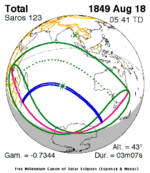 August 18, 1849 (Saros 123) |
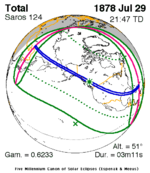 July 29, 1878 (Saros 124) |
 July 10, 1907 (Saros 125) |
 June 19, 1936 (Saros 126) |
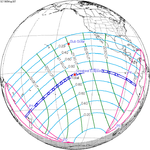 May 30, 1965 (Saros 127) |
 May 10, 1994 (Saros 128) |
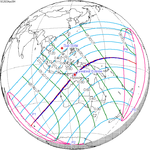 April 20, 2023 (Saros 129) |
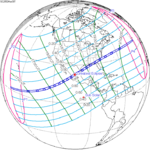 March 30, 2052 (Saros 130) |
 March 10, 2081 (Saros 131) |
 February 18, 2110 (Saros 132) |
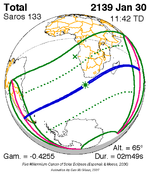 January 30, 2139 (Saros 133) |
 January 10, 2168 (Saros 134) |
 December 19, 2196 (Saros 135) |
|
References
- "May 10, 1994 Annular Solar Eclipse". timeanddate. Retrieved 10 August 2024.
- "Moon Distances for London, United Kingdom, England". timeanddate. Retrieved 10 August 2024.
- Boese, Chandler (May 10, 2021). "Why is Columbus' MLS soccer team called the Crew?". The Columbus Dispatch. Retrieved July 5, 2021.
- "Annular Solar Eclipse of 1994 May 10". EclipseWise.com. Retrieved 10 August 2024.
- van Gent, R.H. "Solar- and Lunar-Eclipse Predictions from Antiquity to the Present". A Catalogue of Eclipse Cycles. Utrecht University. Retrieved 6 October 2018.
- "NASA - Catalog of Solar Eclipses of Saros 128". eclipse.gsfc.nasa.gov.
External links
- Example of total versus annular eclipse
- Earth visibility chart and eclipse statistics Eclipse Predictions by Fred Espenak, NASA/GSFC
